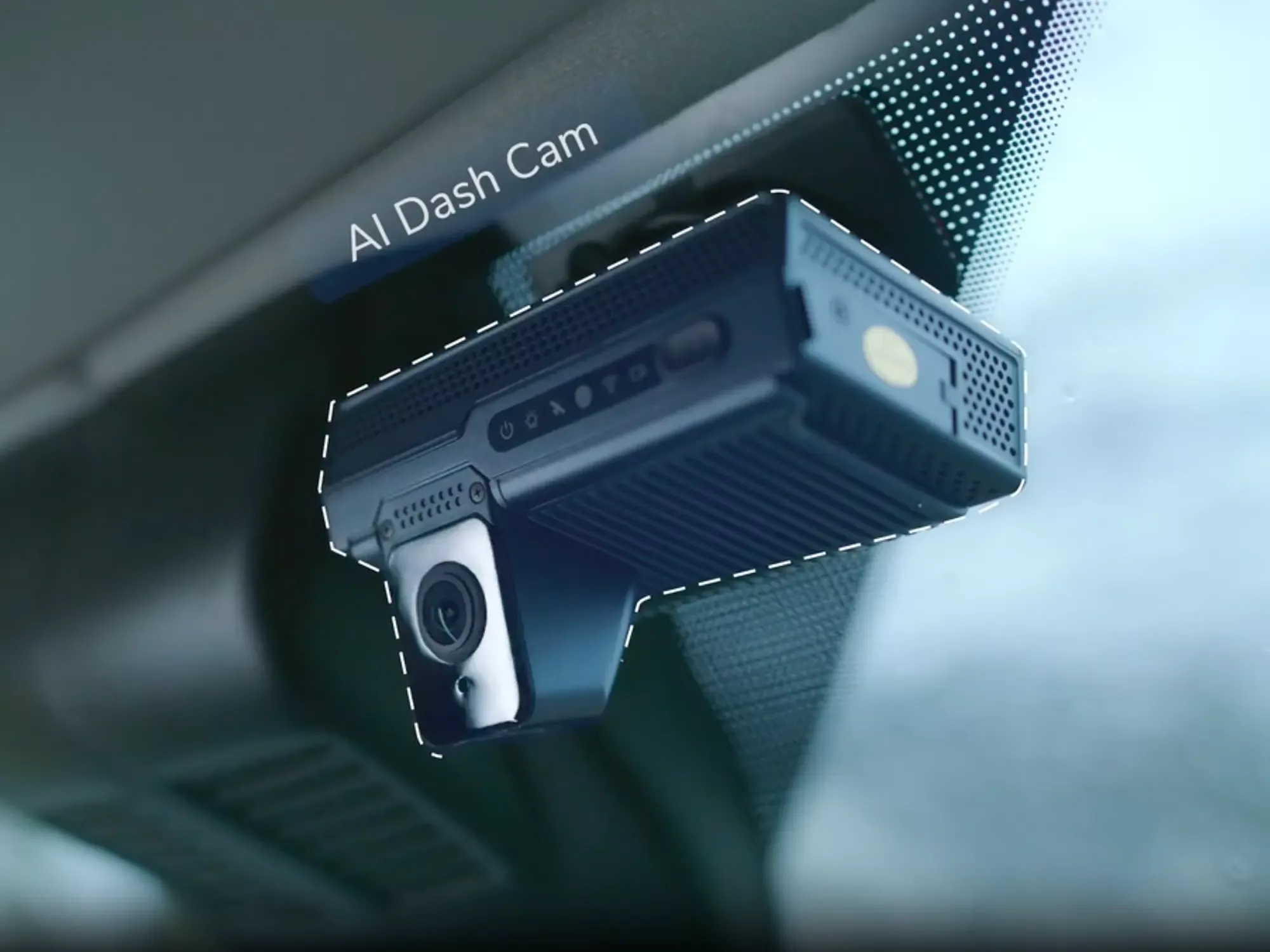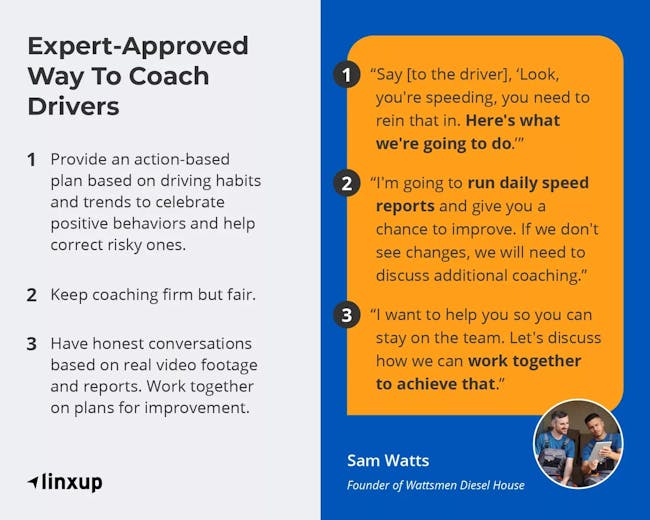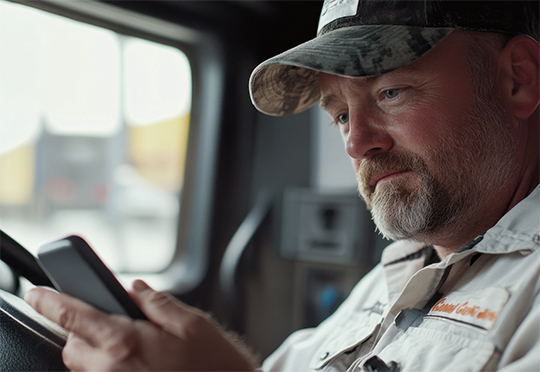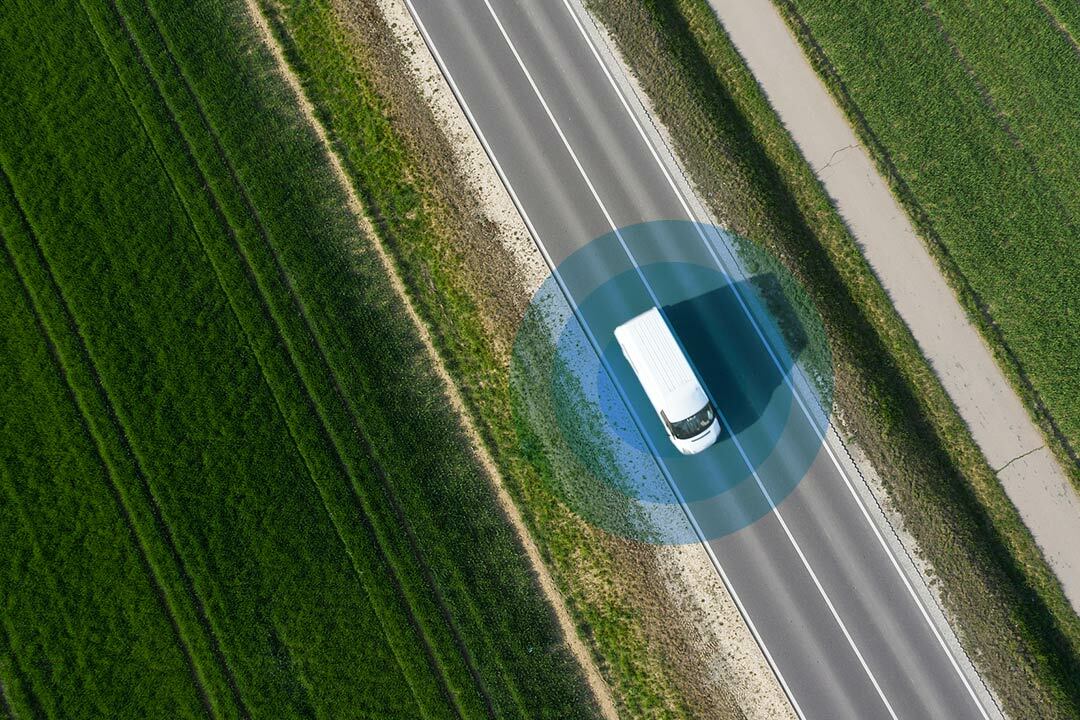
Safety Over Surveillance: Debunking Dash Cam-Based Driver Coaching Fears
A conversation with drivers about fleet safety tech and driver coaching can feel like you’ve brought up the boogeyman. There’s anxiety and worry about the idea of someone watching you, waiting for your guard to be down. But the reality is that dash cams can make the industry better for everyone.
To get a reality check on the power of dash cams, we talked to Sam Watts, the founder of Wattsmen Diesel House and a safety program expert. Sam grew up in the trucking industry and has dedicated his career to providing hands-on safety and compliance training to help fleets of all sizes create a safety culture that sticks with their drivers.
He weighed in on why dash cams are becoming non-negotiable and offers tips on how to create personalized dash cam coaching programs that work without causing friction with your best drivers.
Why investing in dash cam driver coaching pays off
Dash cams do more than record what’s happening on the road, they also provide financial and operational returns.
When used for preventative measures, like coaching drivers before there is a serious accident, dash cams can help keep insurance costs down, get more life out of your vehicles, and build a safety culture that helps attract and retain teams.
Both seasoned drivers and new hires prioritize safe workplaces — no driver wants to risk their life on the job, and we’ve even found that 93% of fleet managers say their drivers perform better when safety is prioritized. Strengthening your driver safety program is low risk, high reward.
Dash cams also help teams stay DOT compliant. With DOT roadchecks occurring more often, dash cam-based driver safety programs provide real-world insights that let fleet managers target problem areas and head into road checks without worry of compromising CSA scores.

What are the main challenges for driver coaching?
Maybe you’re sold on the idea of dash cams to help improve your team’s driving habits, but worry about getting them on board. Or you’re stuck on how you’ll actually use the data to target your specific fleet management challenges. You’re not alone — almost one-third of fleet managers admit to falling behind on fleet safety because they don’t know where to start.
Here are the biggest challenges fleet managers face when it comes to driver coaching and the best ways to get buy-in from your drivers below.
Poor communication
Communication is probably the most common issue when starting driver safety coaching. Unexpected change, especially when it comes to new protocols, can cause drivers to become nervous and worry about the potential risk to their jobs. And no one wins with driver turnover.
The best way to avoid a communication issue is to build rapport with drivers early and often — and it starts with fleet managers and safety professionals. If they only hear from you when they're in trouble, then they’ll always feel on guard.
Getting to know your drivers fosters a better workplace and allows for open, trusting communication between drivers and fleet managers. It’s important to have conversations with drivers instead of talking at them.
Where does dash cam footage come in? It provides context. The goal is to have a discussion on what you’re seeing and create a plan for improvement. Real video footage provides context and accountability, and demonstrates an interest in helping them improve rather than trying to call them out.
“I don't want to coach them and say, ‘Well, [you’re bad] at driving.’ [It would look more like], ‘Hey, man, you're doing this wrong. I want you to do better, so that you can stay on with us so that we don't have to have an unfortunate conversation later on.’” — Sam Watts
Negative perceptions of safety policies
Framing fleet safety policies the right way goes hand in hand with building positive relationships between fleet managers, safety professionals, and drivers. Our research found that half of fleet managers say driver resistance is a major barrier to adopting safety technology.
Some drivers might be wary of surveillance in their vehicles, and fleet managers need to have empathy for their point of view. No one wants to monitor dash cam footage all day — that’s not the goal. The goal is to use footage as needed to protect drivers.
Whether you’re using the footage to support a driver against a false insurance claim or to intervene on speeding habits, that’s where dash cams come in handy — not checking in to see how long a driver stops for lunch.
Sam recommends that safety managers really make an effort to explain the value of dash cams for the drivers. Like any professional relationship, you need to give respect to earn it.
"If you really want to have an effective driver coaching program, you have to make sure that the driver knows that you're not coaching them to be mean. You're coaching them so that you can make them a better driver, and you’re looking out for their best interest.”
Lack of personalization
It’s important to have fleetwide safety meetings and coaching, but that’s not enough if you have drivers who need personal attention. How do you find the balance? Sam recommends hosting monthly company-wide safety coaching to keep safety on everyone’s mind. Riskier drivers will need more personalized one-on-one coaching every week or so.
“Professional athletes watch films of their opponents. They watch films of themselves. Even actors will watch great performances... Why shouldn't drivers be the same way?” — Sam Watts
Not taking full advantage of tech
Most fleets have the tech they need to create driver coaching programs — you’ll struggle to find a fleet that doesn’t have any telematics systems in place. The problem is whether they’re taking full advantage of those systems.
Most fleet managers have the tools to coach a safer fleet, but if their dash cams aren’t set up or monitored, they can’t do their job. The earlier you can properly set up these systems, the sooner you can gather the information you need to set up a safety program that works with your drivers and their habits.
“The biggest key is making sure that if you do implement technology, that you’re monitoring it as well, because if you're not, that could actually come back to bite you.” — Sam Watts
5 tips to build driver-approved dash cam coaching programs
Try not to be discouraged by the obstacles — anything worth doing requires a little effort, and it’s not as complicated as it might seem. Here are some tips to get the most out of a dash cam coaching program:
- Stick to a schedule: Consistency is key, so set fleetwide and personal driver coaching sessions on a weekly to monthly basis, depending on your needs.
- Show real-world examples: Use dash cam footage to provide context and ground coaching programs in reality.
- Acknowledge when drivers make good decisions: Show off footage of drivers thinking on their feet with positive outcomes to reward good habits and show actionable examples of good driving habits.
- Make it fun: A little healthy competition is an excellent motivator. Track behavior that your fleet is targeting, such as speeding alerts, to see which drivers can get the fewest alerts and reward safe driving habits.
- Keep a human touch: Safety protocols are for people, so they should also be created and monitored by people. The social component of driver coaching is the key to how well it works. AI tools can help build these programs, provide alerts, and identify risks, but they can’t build the relationship with drivers that becomes the foundation for an effective program.
If you keep getting alerts for a specific driver, you need to be fair but firm. Sam recommends a “tough love” approach, where you give the driver a measurable goal with realistic outcomes.

Benefits of taking full advantage of dash cams
Dash cam footage comes in handy more than you’d think. The benefits go beyond the obvious role in insurance claims; these tools play a big role in keeping drivers safe on the road.
Better driver safety
A major crash is any driver’s nightmare but fortunately, they are relatively rare. But small accidents like fender benders or backing into poles or mailboxes are more common and can quickly add up. That’s why coaching plans address everyday driving behaviors before they escalate into more serious accidents.
Even a minor injury is still an injury. Dash cam-informed fleet safety and coaching plans keep drivers safe and protect their health, giving them the tools and feedback they need to make safer driving decisions.
Improved driver satisfaction and retention
High driver turnover is a lose-lose-lose situation. It means your drivers aren’t happy, your insurance won’t be happy, and your company is out time, money, and resources needed to hire and train new drivers.
Coaching drivers is a powerful and effective way to reinforce safe habits before issues arise. It gives the driver the opportunity to correct risky behaviors and gain confidence, reducing the chances of a serious accident. Coaching sessions also offer more chances to highlight examples of good behavior, creating more opportunities to give positive feedback that can keep up morale and driver satisfaction.
Protect fleets and drivers
When it comes to insurance, dash cams can be a valuable asset to keep premiums low. However insurance companies also need to see that you are actually using the footage and taking steps to improve safety practices as a result.
Just having fleet technology isn’t enough. According to Sam, if you aren’t properly leveraging the data by monitoring reports and implementing changes, it can turn into a bigger issue than you might think. For example, if there are legal proceedings regarding your fleet and it’s discovered that you had access to dash cam footage but weren’t doing anything with it, this could be seen as a liability.
It also comes in handy if proceedings turn into a “he said, she said” situation. Check out the real footage below from a Linxup dash cam that proved another driver was at fault in a crash.
Reduce overhead costs
Although dash cams do require an investment, they can actually save you money in the long run. The real-time insights not only help you prevent accidents and lower insurance claims, but they also help retain drivers (helping you save on recruitment and training). Dash cam-enabled coaching plans are also more personal and effective, helping you motivate drivers and create a safety culture your team believes in.
Dash cam footage can also inform smarter fleet maintenance plans. You can use reports to identify patterns like harsh braking which could signal it’s time to replace brakes or tires.
Protect your drivers with Linxup’s personalized coaching plans
Driver coaching isn’t surveillance — it’s support. Dash cam-based coaching programs create safer roads, happier drivers, and healthier bottom lines. If there’s one thing you take away from Sam’s insights, it’s that reactive fleet safety or detached, generic approaches aren’t going to cut it.
Don't let your safety technology investment sit idle while your drivers face preventable risks on the road. Discover how LinxCam can help you build personalized coaching programs that protect your drivers, reduce costs, and create a culture of safety that extends far beyond your fleet.
Want to learn more? Contact our team today.



